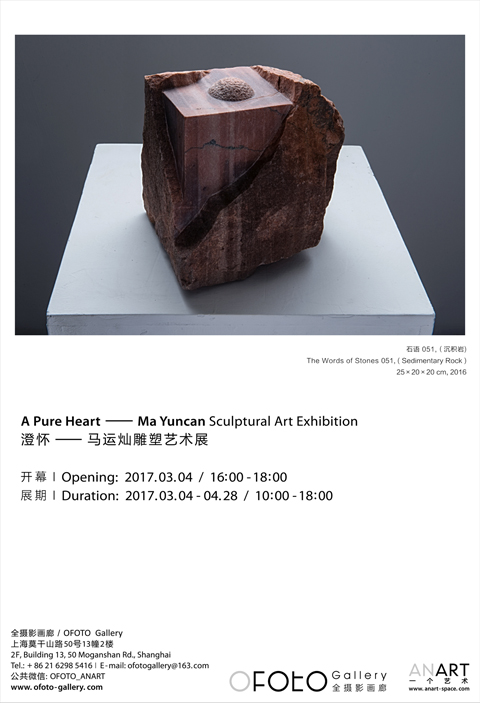- A Pure Heart
- Artist: Ma Yuncan
- Critic: Xu Liang
- Opening: 2017.03.04 / 16:00
- Duration: 2017.03.04 - 04.28 / 10:00 - 18:00
- Address: ANART. 2F, Bldg.13, 50 Moganshan Rd., Shanghai, China

Mellow Melancholy
Ma Yuncan’s sculptures are more than simple manifestations of forms. They embody pieces of his mind which are deeply concerned about the sophistication of human emotions and profound sympathy for human sufferings. These stones are more than they appear to be. Through “cutting, chiseling, and polishing”, he restructures the space and presents a “pure and sophisticated” mix of diverse images. As I always say, minimalist art is not minimal for its own sake but for good reasons. All skills, structures, and use of space are actually manifestations of the artist’s mind. There is no point in categorizing his works as modernist, post-modernist or deconstructionist. What he wants in his works is not s superficial sense of form, but a dynamism that brings back life sealed in the rocks.
For him, “cutting” is a noun while the “stone” is a verb. His works are what I would call a Kafkaesque metaphysical pursuit of spirituality. He walks through in the cities quietly, exploring individual spirit in the distorted collective memory bearing on his shoulders pressure from the society with the kind of courage that reminds you of Borges. Such experience expands our spiritual territory and marks down our nostalgia for old urban and country time, chiseling out puzzle pieces that make the new landscape of the urban civilization. I would try to find the state of mind that allows me to appreciate the abstract elements in the images, and in this way I could avoid oversimplification of the ideas in the works and avoid the stereotypical way of Oriental literati painting. He distilled, reconstructed and transformed certain elements from traditional classics such as “The Valley Creek in Qingyuan” by Xia Gui from the Song Dynasty, as a reinterpretation of the past, present and future. He scatters and aligns personal memories in time and space so as to fabricate a context for physical objects in his artworks. He visualized Luoyang, a time-honored city where he used to live, and the mix of fragmented spaces revealed the way elements of classic Chinese art and contemporary culture could be meet each other. In his works, the rocks are stand-ins for mountains as the way they are in traditional Chinese paintings. The sense of pain and rigidness that comes from cutting and chiseling the rocks brings to his works a philosophical dimension. Every cut brings a new layer to the rocks and therefore adds a new meaning to the work. Just like Mi Fu worships the rocks, he takes the raw context of the rocks into contemporary art language. In this way, he turns the Chinese-garden-like rock forms into fantasy realms and brings out the life and spirit in all details of the rocks.
Through contemporary art, we could challenge conventional art forms so as to better channel art into our daily life. Ma Yuncan’s works bring us onto an odyssey in pursuit of answers in history and our own minds. He narrates and interprets post-modernist industrial civilizations in contrast with a civilization in harmony with nature, and tries to find answers to confusions we have for contemporary life by searching in wasteland of raw rocks. Therefore, he starts from rocks, finds meaning in rocks, and embeds a diverse range of meanings in his artworks made of rocks. Here he shows not just the raw conditions of the material but also the spiritual conditions of the contemporary culture. And then he finds his unique spiritual image and brings about a kind of mellow melancholy on the cultural journey. As we approach his works, we hear his whispers of the stories and reveries about the cultural and social changes.
Hereby I wrote this essay as an introduction to Mr. Ma’s works.
Xu Liang
Feb. 6, 2017 Beijing


